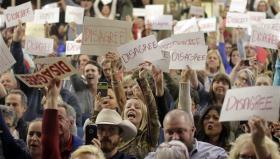Reports on the Resistance: Rebellion in the Town Halls
 Thousands of people showed up at town halls meetings across the United States in February to challenge Republican congressional representatives and senators on their plans for the Affordable Care Act (Obamacare) as well as on issues from immigration, to the environment, to President Donald Trump’s relations with Russia. While this past week fewer protestors took to the streets where radicals have generally taken the initiative and established the tone of the Resistance, town halls swelled with more moderate but quite militant crowds who challenged Republicans and their politics.
Thousands of people showed up at town halls meetings across the United States in February to challenge Republican congressional representatives and senators on their plans for the Affordable Care Act (Obamacare) as well as on issues from immigration, to the environment, to President Donald Trump’s relations with Russia. While this past week fewer protestors took to the streets where radicals have generally taken the initiative and established the tone of the Resistance, town halls swelled with more moderate but quite militant crowds who challenged Republicans and their politics.
The rowdy demonstrations, mostly organized by Democratic Party networks, virtually disrupted a few Republican legislators’ meetings while in most town halls angry voters rose to demand that the health care plan’s fundamental features be preserved, that immigrants’ rights be respected, and that the Environmental Protection Agency be funded. Like those at Representative Jason Chaffetz’s town hall meeting in Cottonwood Heights, Utah, pictured in the AP photo accompany this column, they came prepared to disagree.
Nothing like this has taken place at local town hall gatherings since the rightwing Tea Party’s demonstrations in 2009 and 2010, protests that provided the model for the current left-of-center protests.
Republican Response Divided
The boisterous turnouts succeeded in dividing Republicans on how to handle them. Some Republicans claimed they could not hold old town hall meetings for fear of “leftist violence,” though in reality they feared facing their angry constituents. When U.S. Representative Rodney Frelinghuysen of New Jersey declined to meet with his constituents crowded the Jam-E-Masjid Islamic Center and held a town hall meeting without him. Similar empty-chair events for missing representatives took place in other cities. But some Republican senators and representatives met and debated issues with their constituents and felt the heat.
Trump and other Republicans falsely accused the Democratic Party and liberal organizations of paying “professional protestors.” While Democratic, liberal, and progressive groups have organized most of the protests, with so many furious about Trump’s and the Republicans’ plans, the opposition has not had to pay people to attend. People turned out willingly in droves. Some Republicans such as Rep. Mark Sanford, a South Carolina Republican, conceded that those at his meeting “weren’t a manufactured crowd.” Republican Leonard Lance of New Jersey conceded that the rambunctious groups at his meeting were not paid, they were just constituents.
Indivisible Organizes Democrats
Many of the protests were coordinated through an anti-Trump movement linked to the Democratic Party called “Indivisible” that claims 7,000 affiliated groups throughout the country. The group takes its name from the recently published handbook titled "Indivisible: A Practical Guide for Resisting the Trump Agenda" written by former congressional staffers, Leah Greenberg and Angel Padilla. In New York the Working Families Party, which supports progressive Democratic Party, candidates has also been involved in organizing protests. The American Civil Liberties Union (ACLU) has provided resources to some of the groups the demonstrations.
While they have some overlap with earlier protests such as the Women’s March, the immigrant rights protests at the airports, and the Day with Immigrants demonstrations, the town hall demonstrations represent a different cut of the population. Senior citizens and the middle aged were often present in large numbers, though those in their twenties and thirties who have formed the majority of the street demonstrations also turned out in significant numbers in many locations.
Led largely by Democratic Party-related organizations, the militant town hall protests often had more moderate politics than the crowds in the streets over the past month. Still one saw in the town halls signs for “Single-Payer Health Care” and “No Muslim Ban” and in some cities heard from the floor not only anti-corporate speeches, but occasionally anti-capitalist ones as well.
In February, with the emphasis on Town Hall meetings, the Democratic Party appeared to be taking leadership of the Resistance, the name given to all forms of opposition to Trump. The spring will bring the movement back out into the streets, and if we are to build an independent movement, the radicals will have to begin to take the lead and set the tone.